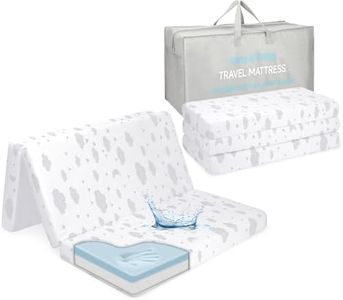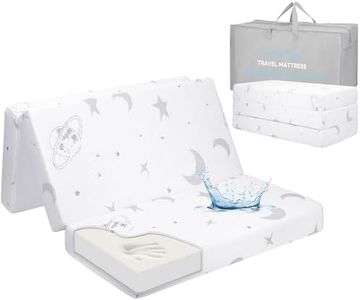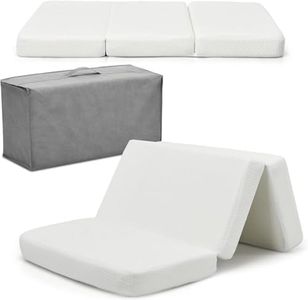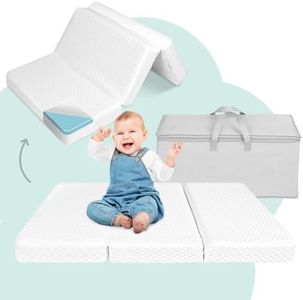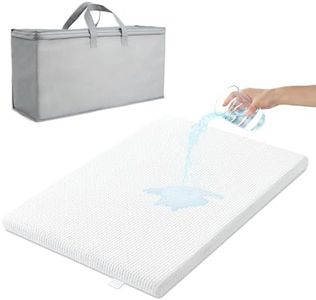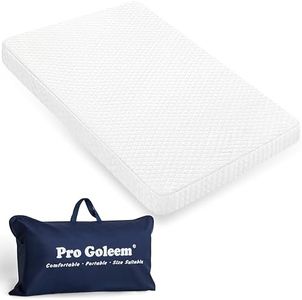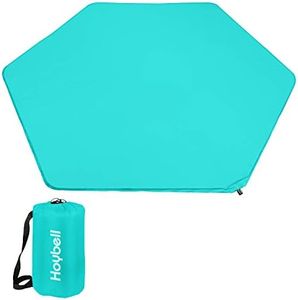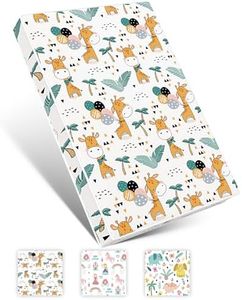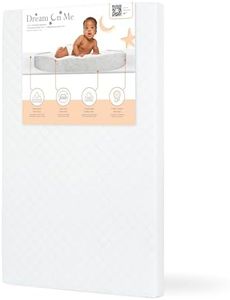We Use CookiesWe use cookies to enhance the security, performance,
functionality and for analytical and promotional activities. By continuing to browse this site you
are agreeing to our privacy policy
10 Best Baby Mattress For Pack N Play
From leading brands and best sellers available on the web.Buying Guide for the Best Baby Mattress For Pack N Play
Choosing the right baby mattress for a pack 'n play is important for your child's safety, comfort, and sleep quality. Since pack 'n plays often come with thin pads, many parents look for a mattress that fits better and provides more support. When shopping, always make sure the mattress is compatible with your specific pack 'n play size and model for a snug, safe fit. Additionally, consider factors related to convenience, ease of cleaning, and materials to ensure a peaceful experience for both you and your baby.Size and FitSize and fit determine whether the mattress sits securely in your pack 'n play without leaving gaps. This is crucial for safety, as gaps between the mattress and the play yard frame can pose a suffocation risk. Mattresses generally come in standard or custom sizes, so you must measure your pack 'n play's interior (length and width) and choose a mattress that matches exactly. A well-fitting mattress should not leave more than a finger-width gap along the sides. Always confirm the manufacturer’s recommended mattress dimensions for your specific pack 'n play to guide your selection.
FirmnessFirmness relates to how hard or soft the mattress feels when pressed. For babies, a firm mattress is critical to support their growing bones and reduce the risk of suffocation or SIDS (Sudden Infant Death Syndrome). Mattresses come in a range from very soft (like adult beds) to very firm (specifically designed for infants). For babies under a year old, always pick the firmest option available, even if it feels hard to an adult, because it provides a safer and more supportive sleep surface.
Mattress ThicknessMattress thickness affects both comfort and whether the mattress will fit securely in your pack 'n play. Thinner mattresses (around 1-2 inches) are lightweight and portable but may offer less cushioning. Thicker mattresses (up to 3 inches) provide more comfort but must still ensure a snug fit under the play yard’s sides. When choosing thickness, make sure it does not compromise the safety rail height and doesn't allow the baby to climb out. For travel, a thinner, foldable mattress may be more convenient, while at home, a slightly thicker mattress can add comfort—always prioritize fit and safety.
Material and Hypoallergenic PropertiesMaterials affect breathability, comfort, and allergy potential. Baby mattresses are often made from different foams, coils, or organic fibers. Hypoallergenic and non-toxic materials minimize the risk of rashes and allergic reactions, especially for sensitive babies. Choose a mattress labeled as free from harmful chemicals like phthalates, lead, and flame retardants if you want extra peace of mind. If your baby has allergies or sensitive skin, hypoallergenic covers or organic natural materials are a smart choice; otherwise, prioritize breathable fabrics and easy-to-clean surfaces.
Waterproof and Washable FeaturesA waterproof surface protects the mattress from spills, accidents, and leaks, making cleanup much easier and keeping germs at bay. Most baby mattresses either have a waterproof layer built in or come with a removable, washable cover. Some can be wiped clean, while others need the cover to be laundered. Consider your lifestyle: if you expect frequent messes, waterproof or machine-washable options will save you time and hassle. For occasional use, a water-resistant cover may be sufficient.
Portability and Folding DesignPortability matters if you plan to take your pack 'n play (and its mattress) on trips, to daycare, or between rooms. Some mattresses are foldable or come with carrying cases for easy transport, while others are one-piece and more suited for stationary use. If you’re often on the move, look for a lightweight, foldable design; for home use, a thicker, non-folding mattress can offer more durability and comfort. Match your choice with how often and where you plan to use the mattress.
